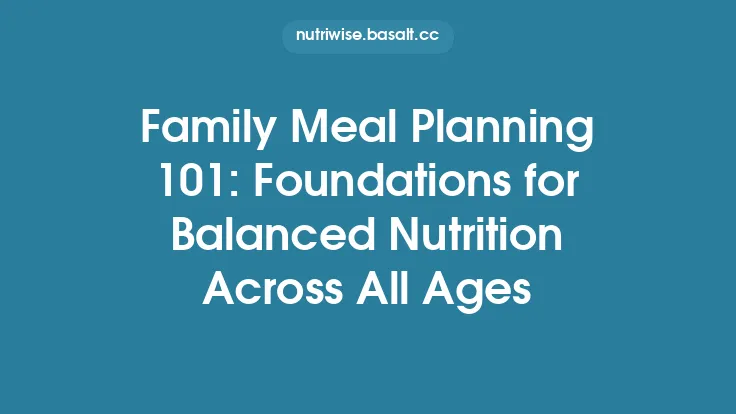South Asian cuisines are built around a rich tapestry of plant‑based staples that have sustained billions of people for centuries. From the fragrant basmati fields of the Indo‑Gangetic plains to the hardy millets of the Deccan plateau, these foods provide the bulk of daily calories while delivering a surprisingly diverse array of nutrients. Understanding how these staples interact—both with each other and with the broader dietary pattern—allows us to craft meals that are not only culturally authentic but also nutritionally balanced for modern health goals.
Core Staples and Their Nutrient Profiles
| Staple | Primary Macronutrient Contribution | Key Micronutrients & Phytochemicals | Typical Serving (g, cooked) | Approx. Energy (kcal) |
|---|---|---|---|---|
| White & Basmati Rice | High‑glycemic carbohydrate (≈28 g/100 g) | Small amounts of thiamine, niacin, iron; trace polyphenols in pigmented varieties | 150 g | 200 |
| Whole‑grain Wheat (Chapati/Paratha) | Complex carbohydrate (≈22 g/100 g) + modest protein (≈7 g) | B‑vitamins (B1, B3, B6), magnesium, zinc, phytate | 100 g | 250 |
| Millets (Ragi, Jowar, Bajra, Foxtail) | Moderate‑glycemic carbs (≈20–25 g) + higher fiber (≈3–5 g) | Calcium (ragi), iron, phosphorus, antioxidants (phenolics) | 100 g | 340 |
| Pulses & Lentils (Toor, Moong, Masoor, Chickpea) | High protein (≈20–25 g) + low‑fat (≈1 g) | Folate, iron, potassium, magnesium, resistant starch | 100 g | 340 |
| Legume‑based Flours (Besan, Urad, Soy) | Protein‑rich (≈20–25 g) + moderate carbs | Vitamin B6, zinc, isoflavones (soy) | 50 g | 180 |
| Root & Tuber Vegetables (Sweet Potato, Taro, Yam) | Complex carbs (≈20 g) + beta‑carotene (sweet potato) | Vitamin A, potassium, dietary fiber | 150 g | 130 |
| Fermented Breads & Batters (Idli, Dosa, Appam) | Balanced carbs + modest protein | Probiotic bacteria, increased bioavailability of B‑vitamins | 2–3 pieces (≈120 g) | 150 |
These staples are rarely consumed in isolation. Traditional South Asian meals pair a carbohydrate base with a protein‑rich dal, a vegetable side, and a condiment (pickle, chutney, or yogurt‑based raita). This synergy is the cornerstone of a nutritionally complete plate.
Complementary Protein Strategies
Plant proteins are often limited by one or more essential amino acids. South Asian cooking naturally overcomes this through protein complementarity:
- Cereal‑Legume Pairing – Wheat or rice combined with lentils or chickpeas supplies a full spectrum of essential amino acids. For example, a typical thali (plate) featuring chapati, dal, and rice delivers a protein quality comparable to animal sources when the portions are balanced (≈1 : 1 – 1 : 2 cereal to legume ratio by weight).
- Mixed Pulse Stews – Combining different dal varieties (e.g., moong + masoor) improves lysine and methionine balance while diversifying micronutrient intake.
- Incorporating Nuts & Seeds – Groundnut, sesame, and pumpkin seed pastes (e.g., *tahini style til ka paste*) add methionine and healthy fats, enhancing satiety and nutrient density.
- Fermentation & Sprouting – Sprouted mung beans or fermented batter (idli/dosa) increase digestibility and raise the bioavailability of lysine and tryptophan.
When planning meals, aim for at least 20–30 g of high‑quality plant protein per main meal for adults, adjusting upward for athletes, pregnant women, or older adults.
Micronutrient Considerations
Iron & Zinc
Pulses and millets are iron‑rich, but non‑heme iron absorption is hindered by phytates. Strategies to boost uptake include:
- Soaking & Fermentation – Soaking lentils for 6–8 h and fermenting batter for 12–16 h reduces phytate content by up to 50 %.
- Vitamin C Pairing – Adding lemon juice, tamarind, or raw mango chutney to dal or rice dishes enhances non‑heme iron absorption.
- Inclusion of Zinc‑dense Foods – Pumpkin seeds, sesame, and chickpeas contribute appreciable zinc; cooking with a modest amount of lemon or tamarind can improve its bioavailability.
Calcium
Ragi (finger millet) is a standout calcium source (≈350 mg per 100 g cooked). Regular consumption of ragi porridge or ragi roti can meet a substantial portion of daily calcium needs, especially when paired with vitamin D‑rich sunlight exposure.
B‑Vitamins & Folate
Whole‑grain wheat, millets, and especially green leafy vegetables (spinach, amaranth) provide folate and B‑vitamins. Fermented foods (idli, dosa) also increase riboflavin and niacin through microbial synthesis.
Vitamin A & Antioxidants
Orange‑fleshed sweet potatoes, carrots, and pumpkin are common in South Asian curries, delivering provitamin A carotenoids. Turmeric, cumin, and coriander add polyphenols with anti‑inflammatory properties.
The Role of Fermentation and Sprouting
Fermentation is a hallmark of South Asian culinary tradition. It serves three primary nutritional functions:
- Enhanced Digestibility – Proteolytic enzymes from lactic acid bacteria break down complex proteins, reducing flatulence often associated with legumes.
- Increased Vitamin Production – Certain strains synthesize B‑vitamins (B12 in some traditional *kanji* preparations, though not reliably) and vitamin K2.
- Phytate Reduction – Acidic environments hydrolyze phytate, freeing minerals for absorption.
Sprouting (e.g., mung bean sprouts) triggers enzymatic changes that raise vitamin C, B‑vitamins, and gamma‑aminobutyric acid (GABA), while lowering antinutrients. Incorporating a handful of sprouts into salads, stir‑fries, or as a garnish on dal adds a fresh nutritional boost.
Diversifying Plant Foods Within the South Asian Palette
While rice, wheat, and lentils dominate, a truly balanced diet leverages the full spectrum of regional produce:
- Leafy Greens – *Saag (mustard greens), palak (spinach), amaranth* (chaulai) provide iron, calcium, and antioxidants.
- Cruciferous Vegetables – *Gobi (cauliflower), cabbage, and broccoli* are increasingly incorporated into curries, delivering sulforaphane and fiber.
- Legume‑Based Snacks – Roasted chickpeas (*chana), spiced peanuts, and bhuna* (dry roasted lentils) serve as nutrient‑dense, portable options.
- Fruit‑Based Condiments – Tamarind, raw mango, and pomegranate arils add tang, vitamin C, and polyphenols.
- Herbs & Spices – Fresh cilantro, mint, curry leaves, and fenugreek leaves contribute micronutrients and phytochemicals that support metabolic health.
By rotating these components across meals, one can avoid monotony while ensuring a broad intake of vitamins, minerals, and phytonutrients.
Practical Meal‑Planning Framework
| Meal | Component | Portion (approx.) | Nutrient Highlights |
|---|---|---|---|
| Breakfast | Idli/Dosa (fermented batter) | 2–3 pieces (120 g) | Probiotic‑rich carbs, moderate protein |
| Sambar (mixed lentil‑vegetable stew) | 150 g | Complete protein, fiber, micronutrients | |
| Coconut chutney (with roasted chana) | 30 g | Healthy fats, vitamin E, protein | |
| Mid‑Morning Snack | Sprouted mung bean salad with lemon | 100 g | Vitamin C, folate, low‑calorie |
| Lunch | Brown basmati rice or millet (e.g., bajra roti) | 150 g | Complex carbs, calcium (ragi) |
| Dal tadka (toor/masoor) | 100 g | High‑quality protein, iron | |
| Mixed vegetable curry (spinach, carrots, cauliflower) | 150 g | Vitamins A, C, K, fiber | |
| Cucumber‑mint raita (plant‑based yogurt) | 50 g | Probiotic, calcium | |
| Afternoon Snack | Roasted chickpeas with spices | 30 g | Protein, fiber, polyphenols |
| Dinner | Whole‑grain wheat chapati (2) | 80 g | B‑vitamins, magnesium |
| Paneer‑free *kadhi* (chickpea‑flour base) | 100 g | Protein, calcium (if fortified) | |
| Stir‑fried bitter gourd & onion | 100 g | Antioxidants, low‑calorie | |
| Fresh fruit (guava or papaya) | 150 g | Vitamin C, dietary fiber |
Guidelines for Portion Control
- Carbohydrate Base: 45–55 % of total daily calories; prioritize whole grains and millets over refined white rice.
- Protein: 15–20 % of calories; achieve through a combination of pulses, legumes, nuts, and seeds.
- Fats: 20–30 % of calories; use cold‑pressed oils (mustard, groundnut, sesame) sparingly; incorporate nuts and seeds for omega‑6/omega‑3 balance.
- Fiber: Aim for ≥25 g/day; achieved through legumes, whole grains, vegetables, and fruit.
Addressing Common Nutritional Gaps
- Vitamin B12 – Predominantly found in animal products. For strict plant‑based adherents, fortified plant milks, nutritional yeast, or a reliable supplement is advisable.
- Omega‑3 Fatty Acids (ALA, EPA/DHA) – Flaxseed, chia, and walnuts provide ALA; algae‑based DHA/EPA supplements can bridge the conversion gap.
- Vitamin D – Sunlight exposure remains the primary source; fortified foods or supplements are recommended during low‑sun months.
- Iodine – Use iodized salt in cooking; seaweed‑based condiments can be incorporated in small amounts for variety.
Sustainability and Cultural Context
South Asian plant‑based staples are intrinsically sustainable:
- Low Input Crops – Millets and pulses thrive on marginal soils with minimal irrigation, reducing water footprints.
- Crop Rotation – Traditional intercropping of legumes with cereals naturally enriches soil nitrogen, decreasing reliance on synthetic fertilizers.
- Minimal Processing – Whole grains and legumes require only basic cleaning, soaking, and cooking, preserving nutrient integrity and limiting energy consumption.
Preserving these practices not only supports health but also aligns with environmental stewardship—a vital consideration for future food security.
Concluding Thoughts
The South Asian plant‑based culinary tradition offers a robust framework for balanced nutrition. By understanding the nutrient composition of core staples, employing complementary protein pairings, enhancing mineral bioavailability through fermentation and sprouting, and diversifying the diet with a wide array of vegetables, fruits, nuts, and seeds, individuals can meet modern nutritional recommendations while honoring cultural heritage. Thoughtful meal planning—grounded in portion control and mindful of common micronutrient gaps—ensures that the diet remains both health‑promoting and sustainable for generations to come.





